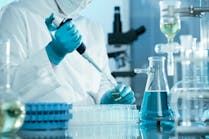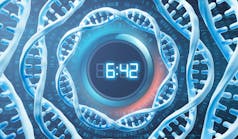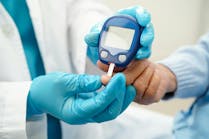Improvements to technologies expand clinical utilization
Polymerase chain reaction (PCR) technology has expanded and changed tremendously since its introduction in 1985.1 The initial method was extremely labor-intensive and time-consuming, but important technological improvements and novel method variations have simplified the process and made clinical implementation much easier. A significant number of clinically relevant questions can now be addressed by utilizing these new methods.
Improving the process
PCR initially required separation of the PCR master mix containing the DNA polymerase, buffer, and the deoxynucleotides from the DNA material to be amplified. Subsequently, twenty years of genetic engineering of the original DNA polymerase and other similar enzymes have resulted in polymerase enzymes that are prevented from activation until the PCR cycling begins. The use of these newer “hot start” enzymes has eliminated this major technical barrier. Another significant efficiency improvement has been the master mix creation steps, which originally were not stable and needed daily preparation; the precise technical nature of this process led to frequent master mix failures. Today, many applications use premade commercially available master mixes stable at 4°C. Newer enzymes stable at -20°C or lower temperatures are also available, facilitating advance preparation of large batches of master mixes that can be stored for several months.2
The introduction of real-time PCR, which combined the use of fluorescently tagged probes with the utilization of PCR thermocyclers with fluorescent detectors, was another significant technological improvement.3 Fluorescently tagged probes bind to the amplified DNA, providing detection of the amount of amplicon being produced as the reaction proceeds, eliminating an additional PCR product detection method (e.g., agarose gel, liquid hybridization, or capillary electrophoresis). Because the assay is constantly monitored, the point in time when fluorescence begins to accumulate in the reaction can be directly related to the amount of original DNA, permitting quantitative PCR in contrast to standard qualitative endpoint PCR. Significant decreases in the contamination rate via the elimination of the necessity to handle the final PCR product improved false positive rates due to amplicon cross-contamination.
Improving instrumentation
PCR instrumentation has also significantly improved. Initial commercial instruments required laser light sources and/or heat-block elements that were relatively slow to cycle to the required temperatures, or utilized thin capillaries that were easily broken and hard to use. Significant technological improvements include utilization of LED light sources, redesign of the heat-block elements to improve cycling times, additional fluorescent detectors, and the identification of alternative strategies to generate fluorescent signals. These enhancements have made it possible to perform a PCR assay in the traditional 96-well PCR plate in as little as 20 to 30 minutes. Miniaturization of the standard PCR tube and instrument to perform a single or small number of samples in a much smaller reaction vessel has the potential to significantly reduce the reagent use and cost, and in addition has further decreased the needed cycling times. The commercialization of many new instrument designs is ongoing and should have a significant impact on PCR-related testing, especially for utilization of PCR testing in smaller hospital settings and point-of-care testing applications.
RT-PCR
Soon after DNA-based PCR methods, the ability to amplify RNA by utilizing reverse-transcriptase (RT) enzymes was introduced. This enzyme creates a single cDNA copy of any RNA present, and then the cDNA can be PCR-amplified with DNA polymerase. Creating cDNA and then amplifying it can be accomplished in either a two-step or a one-step process. A further modification of the one-step method is the use of an enzyme called RTTH, which has both RT and PCR functions depending on the temperature. Variations on RT-PCR methods allow the relatively efficient amplification and detection of RNA in a manner similar to that done for DNA. An alternative strategy for the amplification of RNA involves the utilization of bacterial T7 promoters and RNA polymerase enzymes.
Multiple variations of the original PCR methodology have been clinically developed with modifications to the cycling parameters or enzymes for specific purposes and are described in many published articles. “Touchdown” PCR, in which the first five to 10 cycles are done under less stringent PCR temperatures to allow primers to bind to sequences with partial mismatches, can be used to amplify any of several closely related viruses or bacterial species. Allele-specific PCR, in which the primers or probes are made to specifically anneal or extend over a single-nucleotide mismatch, permits the detection or “typing” of the base at a specific location. Identification of enzymes that can perform DNA or RNA amplification at room temperature can eliminate the need for precise thermocycling, removing the frozen storage requirements for PCR reagents and thermocycling PCR instruments. These advantages over traditional PCR methods have resulted in a number of commercial companies pursuing development of clinical assays with these newer methods and enzymes.
The initial step of preparing purified DNA or RNA for amplification has also been significantly changed to improve quality, purity, and yield as well as efficiency. Instrumentation in development or recently released that couples the extraction and PCR steps allows the complete assay to be performed by the instrument. Extraction methods developed for single/small sample uses that miniaturize this process are currently available and being utilized in some point-of-care or single sample commercial methods. Active research in this area is ongoing and should result in a variety of efficient and low-cost methods and instruments.
Multiplex assays
Initial PCR assays were performed with single primer and probe sets to detect a single sequence of DNA. Soon thereafter, methods permitting more than one reaction to be performed simultaneously in the same tube were utilized. Such multiplex assays are possible provided the primers and probes do not contain similar sequences that cross-hybridize and cause false amplification. These assays use two basic formats, one of which utilizes five to 20 primer sets. After the PCR is done, a second method is required to determine whether any amplicon has been produced or which specific amplicon has been made. The most commonly used detection method is hybridization to a solid-phase target-specific oligonucleotide and then detection with a fluorescent probe, although a variety of other methods have been utilized by commercial manufacturers. A second method utilizes real-time PCR with fluorescent probes, one for each primer set.
In the most common quantitative multiplex real-time PCR assay utilized in clinical laboratories, one primer/probe set is designed to amplify the area of interest (bacteria, virus, human genomic region, etc.) and a second primer amplifies an internal or external control. These can be either a genomic DNA sequence or an alternate non-human, non-pathogen DNA sequence added to the sample prior to extraction. This allows a positive control to be present in every reaction tube, ensuring that the entire process has been done correctly. Because the real-time method requires an additional oligonucleotide for the real-time amplicon detection, it can be more limited in the number of different primer/probe sets that can be used together than is the non-real-time multiplex version.
Digital PCR
An interesting and potentially very powerful PCR modification is digital PCR. There are two major types of digital PCR, droplet-digital PCR (ddPCR) and chamber-digital PCR (cdPCR). Both require specific instrumentation. In ddPCR, the PCR master mix and purified DNA are mixed, and then run through a droplet generator to create 15,000 or more oil-based droplets, each containing PCR master mix and possibly containing the DNA to be amplified. The droplet mix is then used to perform standard PCR. Finally, the mix is analyzed with a droplet-digital PCR instrument, which functions in a manner similarly to a basic flow cytometer to determine the number of droplets that contain fluorescently tagged amplicons.
Because the amount of starting sample is evenly distributed through the droplets, the number of positive droplets is directly related to the concentration of the DNA at the start of the assay. cdPCR utilizes slides with an extremely high number of small wells (20,000+) that compartmentalize the initial DNA present in a manner similar to the ddPCR method. In the cdPCR method, the master mix/DNA sample is placed on the slide, followed by thermocycling and real-time monitoring. Image analysis software is used to determine the total number of fluorescent-positive wells that represent the number of DNA molecules added to the reaction. For both methods, the linear readout of the quantitative result is significantly more reproducible and therefore more accurate than routine real-time PCR.
Current clinical applications
Clinical laboratories are currently utilizing many of these newer PCR methods. In infectious disease testing, PCR detection of more than 100 bacterial and viral agents has proved especially useful for the identification of infections due to newly described infectious agents like coronaviruses and Zika virus. For example, the Molecular Virology Laboratory at the University of Washington tests for more than 30 viruses each week using a variety of methods. Testing for transplant-associated viruses CMV, EBV, and HSV, as well as enterovirus, influenza, and other respiratory viruses, is performed daily six days a week, utilizing methods that on average require two to three hours total test time. The ability of the laboratory to perform clinical testing for this wide variety of viruses in a very timely manner has had a significant impact on the treatment of patients, especially those who have been involved in immunodeficiency-causing transplantation protocols or who have a primary immunodeficiency disease.
PCR testing is also transforming the practice of medicine in transplantation, hematology, and oncology. PCR has essentially replaced serological testing for HLA typing in transplantation and is being used for typing of some blood group systems in blood banks. PCR is also routinely used for engraftment and residual disease testing in transplantation. It is utilized in hematology to detect and monitor a large number of cancer or disease-related cellular components (e.g., BCR-ABL translocations, B and T cell gene rearrangements, BRAF, CMYC, KIT, TP53, and BCL2). In both hematology and oncology, there is an expanding use of ddPCR multiplex assays, with eight or more diagnostic or prognostic markers being utilized which identify genetic mutations, rearrangements, and expression of RNA associated with malignancy or host immune response genes. More recently, using plasma as a source of a “liquid biopsy,” PCR of DNA fragments in blood in limited studies has shown strong potential to both aid in the diagnosis of a variety of cancers and be useful in serial monitoring for tumor response and recurrence, replacing several less sensitive and less specific immunoassay methods.4 Further studies are required, but the potential for the clinical utility of a large number of “cancer” related markers detected by PCR appears to be very strong.
In summary, PCR technology has been broadly applied and modified to produce many related technologies for utilization in clinical laboratories to perform many critical tests not previously available. PCR testing will retain an important place for rapid, targeted clinical molecular diagnostics spanning multiple medical disciplines even in the era of next-generation sequencing. In some cases, this will be performed within a traditional centralized core facility model, but it may over time expand into increasing near-to-patient testing as the technology continues to become more robust and easier to operate.
REFERENCES
- Saiki RK, Scharf S, Faloona F, et al. Enzymatic amplification of beta-globin genomic sequences and restriction site analysis for diagnosis of sickle cell anemia. Science. 1985;230(4732):1350-1354.
- Glover WA, Atienza EE, Nesbitt S, et al. Evaluation and utilization of preassembled frozen commercial fast real-time qPCR master mixes for detection of cytomegalovirus and BK virus. J Med Virol. 2016;88(1):115-119.
- Higuchi R, Dollinger G, Walsh PS, Griffith R. Simultaneous amplification and detection of specific DNA sequences. Biotechnology.1992;10(4):413-417.
- Gold B, Cankovic M, Furtado LV, Meier F, Gock CD. Do circulating tumor cells, exosomes, and circulating tumor nucleic acids have clinical utility? J. Mol Diagnostics. 2015;17(3)209-224.
Linda Cook, PhD, D(ABMLI), is the Director of Molecular (PCR) Virology in Laboratory Medicine at the University of Washington Medicine and a Research Scientist at the Fred Hutchinson Cancer Research Center.





